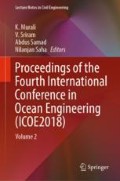Abstract
There is a long pending need for a deep-drafted port in West Bengal which will serve complete East and North East region of India. The port operation in Hooghly estuary starts in Kolkata in the eighteenth century. This is the only riverine port in India which started its operation with an approach channel of around 232 km from the sea (Sand Heads). Thereafter, due to problem of siltation and to accommodate the bigger size of vessels, another Satellite Dock System (Haldia Dock Complex, i.e. HDC) started its operation from 1974 with 9.5 m average draft, whereas the draft available at Kolkata Dock System (KDS) at that time was varying between 7.5 and 8.0 m. Due to adverse morphological transformation, over the decade, at present, the natural depth in and in front of Hooghly estuary varies between 5 and 7 m. So, looking for deep-drafted port in and in front of Hooghly estuary is ruled out. It is required to see the site on East side and West side of Hooghly estuary. Unfortunately, on East and West, the extent of coastline is small. On the East side lies the Sundarban Delta mostly formed by alluvial sediment brought by Hooghly estuary. Subsoil is mostly formed of silty clay unsuitable for port construction. It is also observed that while flood flow enters the estuary with equally distributed over width, the ebb flow moves to East after leaving the estuary. Any attempt to develop a port on East side has to tackle with enormous sediment brought by the estuary. Hence, one has to look towards West for deep-drafted port. Coastline in this stretch is limited. On West side, characteristics of the formation of channels like Eden channel and channel West of Eastern brace, which are wide in deep region and gradually narrows down as they move upstream, indicate that they are flood channels. The advantage of flood channels is that here it is not required to tackle the sediment brought by estuary. They are stable and maintained more or less at same location. Another expectation is that during prehistoric era when reaching of sand to coast through river was not intercepted by dams and movement along coast was not intercepted by port structures and approach channel, West side of Hooghly estuary has intercepted the sand. Outfall of estuary works as sand barrier. There is good chance that subsoil in this area is formed of sand. Existence of number of sand heads for centuries is proof of that. Submerged sands on two sides will give protection from cyclones. Coastal formation dictates that deep-drafted port in this region has to be formed as Island port. Considering all these aspects, the deep flood channel West of eastern brace provides excellent site for deep-drafted Island port. An attempt has been made in this paper to logically reinforce the merits in favour of Island port in reference to other available options, within the jurisdiction of West Bengal.
Access this chapter
Tax calculation will be finalised at checkout
Purchases are for personal use only
References
Ghosh SN (1997) Tidal hydraulic engineering. Oxford and IBH Publishing Co. Pvt. Ltd., New Delhi
Kray CJ (1970) Supership effect on waterway depth and alignments. J Waterways and Harbours Div ASCE 96. WW2 paper 7305, May
Manaus MC, Irving R (1976) Reclamation dredging and instrumentation proc symposium on dredging, London Institution of Civil Engineers (London)
Shariff S (2005) Cost benefit in dredging projects, expertise in laying and maintenance of discharge pipelines. Dredging Seminar 2005, DCI of India
van de Ridder KH, de Wit PC (1987) The effective development of trailing suction hopper dredgers in the port of Rotterdam. Maintenance dredging. Proc. Of conference organised by ICE, London at Bristol, 1987 Thomas Talford
Acknowledgements
The authors are indebted to the competent authorities of CWPRS, KoPT and WAPCOS for providing the required information and wish to convey their sincerest thanks for the constant support and encouragement bestowed towards publication of the paper.
Author information
Authors and Affiliations
Corresponding author
Editor information
Editors and Affiliations
Rights and permissions
Copyright information
© 2019 Springer Nature Singapore Pte Ltd.
About this paper
Cite this paper
Krishna, B., Chaudhuri, B., Bhaskaran, P.K. (2019). A Study to Identify Locations Suitable of Deep Sea Port Operations in the State of West Bengal. In: Murali, K., Sriram, V., Samad, A., Saha, N. (eds) Proceedings of the Fourth International Conference in Ocean Engineering (ICOE2018). Lecture Notes in Civil Engineering , vol 23. Springer, Singapore. https://doi.org/10.1007/978-981-13-3134-3_44
Download citation
DOI: https://doi.org/10.1007/978-981-13-3134-3_44
Published:
Publisher Name: Springer, Singapore
Print ISBN: 978-981-13-3133-6
Online ISBN: 978-981-13-3134-3
eBook Packages: EngineeringEngineering (R0)

